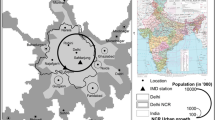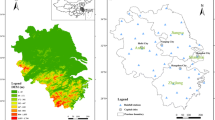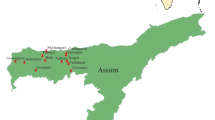Abstract
This paper is intended to ascertain the spatial pattern of extreme rainfall distribution in Peninsular Malaysia at several short time intervals, i.e., on hourly basis. Motivation of this research is due to historical records of extreme rainfall in Peninsular Malaysia, whereby many hydrological disasters at this region occur within a short time period. The hourly periods considered are 1, 2, 3, 6, 12, and 24 h. Many previous hydrological studies dealt with daily rainfall data; thus, this study enables comparison to be made on the estimated performances between daily and hourly rainfall data analyses so as to identify the impact of extreme rainfall at a shorter time scale. Return levels based on the time aggregate considered are also computed. Parameter estimation using L-moment method for four probability distributions, namely, the generalized extreme value (GEV), generalized logistic (GLO), generalized Pareto (GPA), and Pearson type III (PE3) distributions were conducted. Aided with the L-moment diagram test and mean square error (MSE) test, GLO was found to be the most appropriate distribution to represent the extreme rainfall data. At most time intervals (10, 50, and 100 years), the spatial patterns revealed that the rainfall distribution across the peninsula differ for 1- and 24-h extreme rainfalls. The outcomes of this study would provide additional information regarding patterns of extreme rainfall in Malaysia which may not be detected when considering only a higher time scale such as daily; thus, appropriate measures for shorter time scales of extreme rainfall can be planned. The implementation of such measures would be beneficial to the authorities to reduce the impact of any disastrous natural event.







Similar content being viewed by others
References
Acreman MC (1990) A simple stochastic model of hourly rainfall for Farnborough, England. Hydrol Sci J 35:119–148
Ariff NM, Jemain AA, Ibrahim K, Wan Zin WZ (2012) IDF relationships using bivariate copula for storm events in Peninsular Malaysia. J Hydrol 470–471:158–171. doi:10.1016/j.jhydrol.2012.08.045
Chow VT, Maidment DR, Mays LW (1988) Applied hydrology, international editions. McGraw-Hill, Singapore
Coles S (2001) An introduction to statistical modeling of extreme values. Springer, London
Cunnane C, (1989) Statistical distributions for flood frequency analysis. World Meteorological Organization operational hydrology, report no. 33, WMO-No.718, Geneva, Switzerland
Eli A, Shaffie M, Wan Zin WZ (2012) Preliminary study on Bayesian extreme rainfall analysis: a case study of Alor Setar, Kedah, Malaysia. Sains Malaysiana 41:1403–1410
Fowler HJ, Kilsby CG (2003) A regional frequency analysis of United Kingdom extreme rainfall from 1961 to 2000. Int J Climatol 23:1313–1334, doi: 0.1002/joc.943
Glasbey GA, Cooper G, McGechan MB (1995) Disaggregation of daily rainfall by condition simulation from a point-process model. J Hydrol 165:1–9
Guenni L, Bardossy A (2002) A two step disaggregation method for highly seasonal monthly rainfall. Stoch Env Res Risk A 16:188–206. doi:10.1007/s00477-002-0094-4
Hosking JRM, Wallis JR (1987) Parameter and quantile estimation for the generalized Pareto distribution. Technometrics 29:339–349. doi:10.1080/00401706.1987.10488243
Hosking JRM, Wallis JR (1997) Regional frequency analysis: an approach based on L-moments. Cambridge University Press, New York
Hosking JRM, Wallis JR, Wood EF (1985) Estimation of the generalized extreme-value distribution by the method of probability-weighted moments. Technometrics 27:251–261. doi:10.1080/00401706.1985.10488049
Koutsoyiannis D, Kozonis D, Manates A (1998) A mathematical framework for studying rainfall intensity–duration–frequency relationships. J Hydrol 206:118–135. doi:10.1016/S0022-1694(98)00097-3
Nadarajah S, Choi D (2007) Maximum daily rainfall in South Korea. J Earth Syst Sci 116:311–320
Shinyie WL, Ismail N, Jemain AA (2013) Semi-parametric estimation for selecting optimal threshold of extreme rainfall events. Water Resour Manag 27:2325–2352. doi:10.1007/s11269-013-0290-7
Suhaila J, Deni SM, Wan Zin WZ, Jemain AA (2010) Spatial patterns and trends of daily rainfall regime in Peninsular Malaysia during the southwest and northeast monsoons: 1975–2004. Meteorog Atmos Phys 110:1–18. doi:10.1007/s00703-010-0108-6
Vogel RM, Fennessey NM (1993) L-moment diagrams should replace product moment diagrams. Water Resour Res 29:1745–1752. doi:10.1029/93WR00341
Wan Zin WZ, Jemain AA (2010) Statistical distributions of extreme dry spell in Peninsular Malaysia. Theor Appl Climatol 102:253–264. doi:10.1007/s00704-010-0254-2
Wan Zin WZ, Jemain AA, Ibrahim K, Jamaludin S, Deni SM (2009a) A comparative study of extreme rainfall in Peninsular Malaysia: with reference to partial duration and annual extreme series. Sains Malaysiana 38:751–760
Wan Zin WZ, Ibrahim K, Jemain AA (2009b) The best fitting distribution of annual maximum rainfall in Peninsular Malaysia based on methods of L-moment and LQ-moment. Theor Appl Climatol 96(3–4):337–344. doi:10.1007/s00704-008-0044-2
Wan Zin WZ, Jamaludin S, Deni SM, Jemain AA (2010) Recent changes in extreme rainfall events in Peninsular Malaysia: 1971–2005. Theor Appl Climatol 99(3):303–314. doi:10.1007/s00704-009-0141-x
Wan Zin WZ, Jemain AA, Ibrahim K (2012) Bayesian changepoint analysis of the extreme rainfall events. J Math Stat 8:85–91
Yu R, Li J, Yuan W, Chen H (2010) Changes in characteristics of late-summer precipitation over Eastern China in the past 40 years revealed by hourly precipitation data. J Clim 23:3390–3396. doi:10.1175/2010JCLI3454.1
Zalina MD, Desa MN, Nguyen VTV, Hashim MK (2002) Selecting a probability distribution for extreme rainfall series in Malaysia. Water Sci Technol 45:63–68
Acknowledgments
The authors are indebted to the staff of Drainage and Irrigation Department Malaysia for providing the hourly rainfall data for this study. The authors also would like to express their gratitude to the referee for the constructive comments and suggestions. This research would not have been possible without the sponsorship from the Ministry of Higher Education Malaysia. This research was funded by grant number LRGS/TD/2011/UKM/PG/01 and DPP-2014-106.
Author information
Authors and Affiliations
Corresponding author
Rights and permissions
About this article
Cite this article
Shaffie, M., Eli, A., Wan Zin, W.Z. et al. The spatial return level of aggregated hourly extreme rainfall in Peninsular Malaysia. Theor Appl Climatol 121, 61–69 (2015). https://doi.org/10.1007/s00704-014-1222-z
Received:
Accepted:
Published:
Issue Date:
DOI: https://doi.org/10.1007/s00704-014-1222-z




